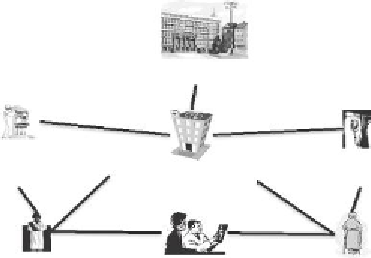what-when-how
In Depth Tutorials and Information
Oversight
Lab
Administration
ER
Doctor
Consultation
Patient
Figure 14.5
Basic telemedical network model. (From Cynthia LeRouge, Alan
Hevner, Rosann Collins, Monica Garield, David Law. Telemedicine encounter
quality: comparing patient and provider perspectives of a socio-technical sys-
tem.
Proceedings of the 37th Annual Hawaii International Conference on System
Sciences (HICSS'04)
,Track6,HICSS,Vol.6,pp.60149a.2004.)
videoconferencing?). he second form of quality is based on the actual clinical
encounter results. Good examples of this form would be the accuracy of any diag-
noses reached, and the satisfaction of the patients and staff with the system.
While there are standards governing the quality of those two forms indepen-
dently, there has only recently been a push to develop standards encompassing
all aspects of the problem. Healthcare standards such as the Joint Accreditation
of Healthcare Organizations, and information systems standards such as the
International Multimedia Telecommunications Consortium, provide very dif-
ferent ideas on how quality should be reached. In each case, one side largely
ignores the other and fails to address important issues, such as the amount of
information that can be relayed electronically effectively or the ability of the
patient to feel like an active and important participant in the medical discus-
sions taking place.
Any analysis of a sociotechnical system must be approached from multiple per-
spectives. For instance, colloquial speech of the medical staff might be jargon to the
patients, and the opposite could very well be true. So, instead, a model is created
wherein the analysis approaches the system from a provider and a patient point
of view. he system must be functional for the provider to provide quality service
while being worthwhile and friendly to the patient in order to be a successful prod-
uct in a business sense.
he methods used to properly examine such a system must likewise be quite var-
ied. It must examine a structure where the quality of individual elements contrib-
utes to the interactions of the more functional perceived components (Figure 14.6).
A mixture of examining evidence of the effective history of telemedicine, real

